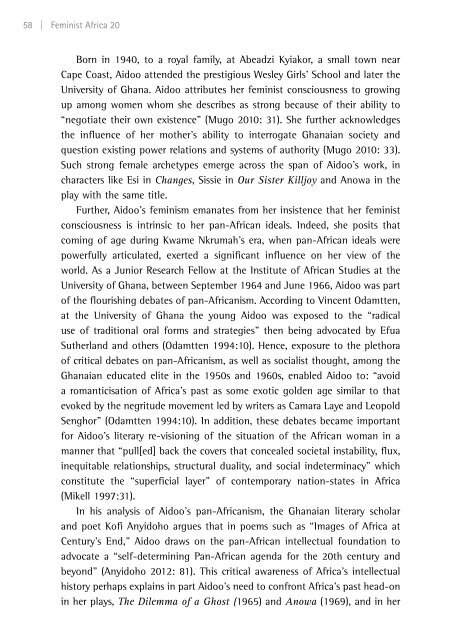You also want an ePaper? Increase the reach of your titles
YUMPU automatically turns print PDFs into web optimized ePapers that Google loves.
58 | Feminist Africa 20<br />
Born in 1940, to a royal family, at Abeadzi Kyiakor, a small town near<br />
Cape Coast, Aidoo attended the prestigious Wesley Girls’ School <strong>and</strong> later the<br />
University of Ghana. Aidoo attributes her feminist consciousness to growing<br />
up among women whom she describes as strong because of their ability to<br />
“negotiate their own existence” (Mugo 2010: 31). She further acknowledges<br />
the influence of her mother’s ability to interrogate Ghanaian society <strong>and</strong><br />
question existing power relations <strong>and</strong> systems of authority (Mugo 2010: 33).<br />
Such strong female archetypes emerge across the span of Aidoo’s work, in<br />
characters like Esi in Changes, Sissie in Our Sister Killjoy <strong>and</strong> Anowa in the<br />
play with the same title.<br />
Further, Aidoo’s feminism emanates from her insistence that her feminist<br />
consciousness is intrinsic to her pan-African ideals. Indeed, she posits that<br />
coming of age during Kwame Nkrumah’s era, when pan-African ideals were<br />
powerfully articulated, exerted a significant influence on her view of the<br />
world. As a Junior Research Fellow at the Institute of African Studies at the<br />
University of Ghana, between September 1964 <strong>and</strong> June 1966, Aidoo was part<br />
of the flourishing debates of pan-<strong>Africanism</strong>. According to Vincent Odamtten,<br />
at the University of Ghana the young Aidoo was exposed to the “radical<br />
use of traditional oral forms <strong>and</strong> strategies” then being advocated by Efua<br />
Sutherl<strong>and</strong> <strong>and</strong> others (Odamtten 1994:10). Hence, exposure to the plethora<br />
of critical debates on pan-<strong>Africanism</strong>, as well as socialist thought, among the<br />
Ghanaian educated elite in the 1950s <strong>and</strong> 1960s, enabled Aidoo to: “avoid<br />
a romanticisation of Africa’s past as some exotic golden age similar to that<br />
evoked by the negritude movement led by writers as Camara Laye <strong>and</strong> Leopold<br />
Senghor” (Odamtten 1994:10). In addition, these debates became important<br />
for Aidoo’s literary re-visioning of the situation of the African woman in a<br />
manner that “pull[ed] back the covers that concealed societal instability, flux,<br />
inequitable relationships, structural duality, <strong>and</strong> social indeterminacy” which<br />
constitute the “superficial layer” of contemporary nation-states in Africa<br />
(Mikell 1997:31).<br />
In his analysis of Aidoo’s pan-<strong>Africanism</strong>, the Ghanaian literary scholar<br />
<strong>and</strong> poet Kofi Anyidoho argues that in poems such as “Images of Africa at<br />
Century’s End,” Aidoo draws on the pan-African intellectual foundation to<br />
advocate a “self-determining <strong>Pan</strong>-African agenda for the 20th century <strong>and</strong><br />
beyond” (Anyidoho 2012: 81). This critical awareness of Africa’s intellectual<br />
history perhaps explains in part Aidoo’s need to confront Africa’s past head-on<br />
in her plays, The Dilemma of a Ghost (1965) <strong>and</strong> Anowa (1969), <strong>and</strong> in her


